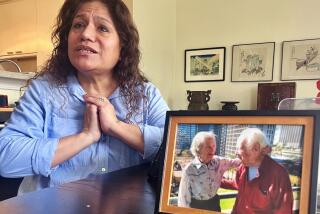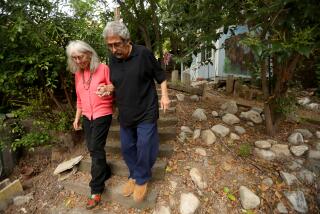Unraveling the Past
- Share via
Seated in her recliner in the family room of the Long Beach duplex she shares with her identical twin, 87-year-old Ilene Eddy is reminiscing about their childhood back on the family farm in Iowa.
At least she’s trying to.
Her twin, Irene Peterson, a few feet away in her own recliner with its matching floral chair cover, keeps interrupting.
“Irene, be quiet, please!” Ilene says. “I’m trying to give information here.”
Memories of the old days, when their mother dressed them in matching outfits and they rode a horse-drawn buggy to a country school, are in easy reach for Ilene. But, because she’s in the early stages of Alzheimer’s disease, details of the recent past are much harder to grasp.
Irene is in an advanced stage of the disease. For her, past and present are a blur. Unable to hold a normal conversation, Irene keeps up running commentary.
“Oh, they’ve got some spades,” she happily announces, then says: “You have to be good to your parents.”
It’s early afternoon. Normally, the twins--in matching blue dresses--would be watching television. Game shows and a religious channel are their favorites. But today, Ilene has been asked to talk about her and Irene’s past.
“I think we enjoyed life, and we were together, but now we’re getting old and forgetful,” Ilene says. Then she jokes: “I’m glad my name’s short so I can remember it.”
It is a difficult process, piecing together the life story of a person whose memory is failing. That’s one of the challenges for researchers seeking clues into the causes of Alzheimer’s disease.
In the case of Ilene and Irene, researchers are interested not only in their broad stories but also in the details--how their lives have been similar and dissimilar.
Researchers say there are likely differences in the twins’ exposure to potential nongenetic risk factors for Alzheimer’s such as occupation, medical history, medications and exposure to toxic substances such as pesticides and solvents.
By combining Ilene’s recollections with information from friends and relatives, the twins’ stories emerge.
Although their paths diverged in Iowa in the early ‘40s and intersected again in Southern California later that decade, Ilene and Irene have led remarkably parallel lives. And, according to their nephew Larry Lindgren of Camarillo, the twins have always enjoyed good health.
Born on Jan. 30, 1911, the sisters grew up with eight brothers and sisters on their family’s 160-acre farm in western Iowa, about 100 miles southeast of Sioux City.
“Our place was one of the few ones that was modern,” Ilene says. They had electricity supplied by batteries in the basement of their big, two-story farmhouse. A farm with electricity was so unusual in the area at the time, she recalls, that the local newspaper came out and took a picture.
They went to Sunday school “because we wanted to” Ilene says.
And they always got along.
“We have a sister Ruth that’s just a few years older, and we’d sometimes get mad over something, and Ruth would kind of stick up for one or the other. But it wasn’t long before the twins were against her.”
It’s a story Ilene will repeat several times over the next hour.
The twins didn’t go to college, says their nephew, and both began working while still in high school.
“They originally sold cosmetics for a woman called Dr. Namour,” Lindgren says. When Namour moved, the twins started their own small cosmetics manufacturing company, selling products throughout the Midwest.
Lindgren, 71, remembers that “as a youngster what impressed me when they were touring around in this cosmetics business is they had somehow acquired a big Cadillac with big wood-spoke wheels and a V-8 engine. It was really a fancy bus.”
After a few years, he says, “they decided that traveling wasn’t the way to go,” and they opened a beauty shop in Sioux City.
Talk of the beauty shop sparks a pleasant memory in Irene.
“Oh, we had a very nice place,” she says. “Very nice heads. Because our hairs were going to college.”
In the mid-1930s, Irene wed dairy farmer Roy Peterson. The couple moved to Bellflower about 1944 and Roy got a job as a pipe-fitter for Shell Oil. Irene sold household products through parties in customers’ homes.
Ilene ended up working as a secretary for the civil service--first in Utah, then in Hawaii and Guam during World War II. After the war, she got a secretarial job at Veterans Hospital in Long Beach. In the mid-1950s she married Elmer Eddy, a retired Episcopal minister who had once preached on the radio in Boston.
In the mid-’50s, Ilene and Irene set up their households within five blocks of each other in Seal Beach. Neither had children. Husband Elmer died in 1970; Roy in ’71.
Not long after the deaths, the widows bought their duplex in Long Beach--Irene living on one side, Ilene in the other.
That’s how Gus Modaffari, 65, a Seal Beach real-estate broker who eventually became the twins’ property manager, met them.
Despite their close physical appearance, Modaffari recalls personality and lifestyle differences between the two.
“Irene was the strongest, more masculine, more forward,” he says. “She smoked with me a long time. She drank with me. Irene liked straight whiskey, whereas Ilene liked mixed drinks. We’re talking, like, one--if you were lucky.”
Both sisters are very religious, he says, and once belonged to two or three churches.
Despite a good income from rental properties they own, they have always been thrifty. Says longtime friend Thera Boyer: “They were penny wise and pound foolish many times.”
Like the time they took a cruise to Alaska because the rates were low. But, Boyer, recounts with a laugh, “they never saw a thing. It was all fogged in.” Then there was the reduced-fare trip to China in the off-season: It was so cold they both got pneumonia.
But the twins took it all in stride.
“They would laugh about it as hard as you would,” Boyer says.
What the details of the sisters’ lives offer researchers is a puzzle.
Duke University researchers studying twins with Alzheimer’s begin by learning all they can about the twin-pair members’ lives. In July, a nurse and neuropsychological technician from Duke visited Ilene and Irene to review their medical history and conduct a physical examination and neuropsychological testing for memory, language and complex thinking.
The researchers are also interviewing family members to gather information about potential risk factors for Alzheimer’s that the twins may have been exposed to.
Researchers know that genes play a major role in the disease, says Brenda Plassman, one of the investigators in the Duke study. But, she says, the twin studies “are really key to showing that it’s not just genes.”
Studies have reported that head trauma and fewer years of education may be potential risk factors for Alzheimer’s. Yet Plassman emphasizes that “virtually no potential nongenetic risk factor except age has been shown to hold up in all studies.”
From a scientific point of view, studying identical twins “is very helpful,” says Dr. Gary Small, a professor of psychiatry at UCLA and director of the university’s studies of early detection of Alzheimer’s and treatment of people with mild cognitive complaints.
“If Alzheimer’s were 100% genetic, then you’d see, if one identical twin got the disease . . . 100% of the time the other would. But you don’t see that. If one twin gets the disease, the risk for the other twin is approximately 50%, which is much higher than you see in the general population.”
Plassman praises twins such as Ilene and Irene--and their families--for volunteering for a scientific study.
“If you think what they’re struggling to cope with, and yet they still invite us into their lives,” she says, “that’s an unbelievably generous gift.”
And, while the twins’ failing memories make it hard for them to contribute some of the concrete information researchers are looking for, they enjoy sharing the memories they do have.
Especially from childhood.
As kids, Ilene says, they never objected to being dressed alike.
But did they tire of it?
“I think some people did,” Ilene says with a laugh, “but we never did.”
(BEGIN TEXT OF INFOBOX / INFOGRAPHIC)
ALZHEIMER’S FACTS
* Causes of Alzheimer’s are unknown and currently receiving intensive investigation. Among suspected causes: diseased genes or a genetic predisposition, abnormal protein build-up in the brain and environmental toxins.
* Scientists in the fields of genetics, pathology, immunology, toxicology, neurology, psychiatry, pharmacology, biochemistry and epidemiology are among those working to find causes, treatments and cures for the disease.
Source: Alzheimer’s Assn.





